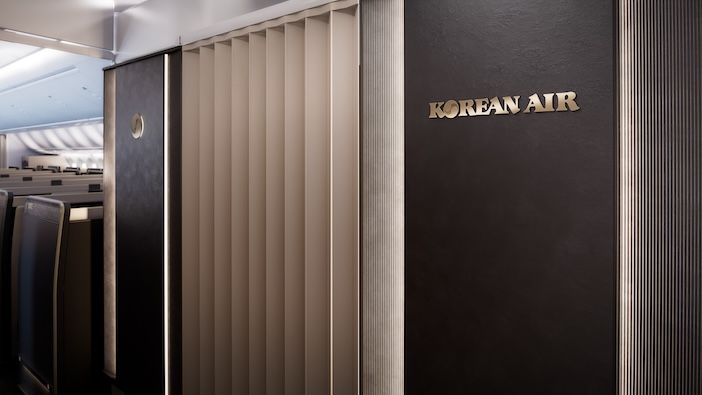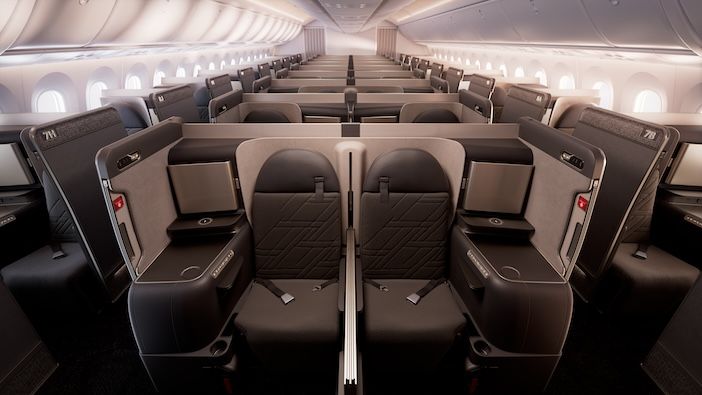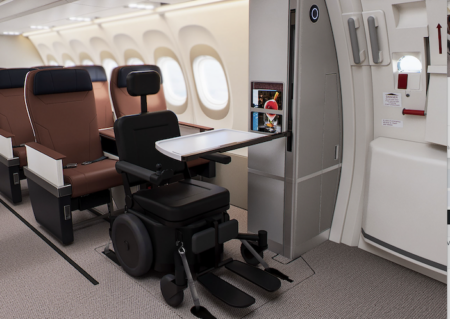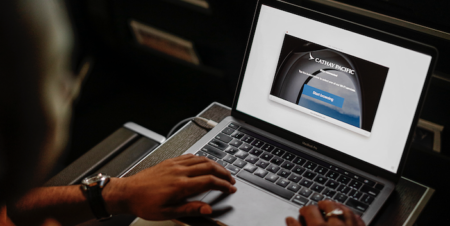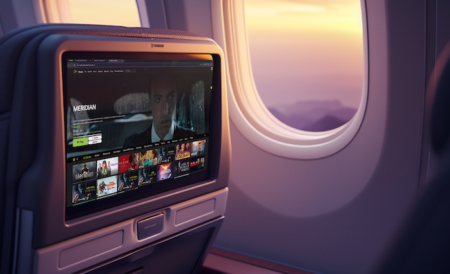Korean Air has taken delivery of its first Boeing 787-10 Dreamliner, with a highlight of the 325-seat aircraft being the new Prestige Class (business class) cabin interior. The new cabin identity will be integrated in the airline’s 787-9 and 787-10 aircraft, with influences from the designs also due to carried over to the airline’s A321Neo aircraft interiors.
The B787-10 Prestige Class cabin features 36 enclosed suites, named ‘Prestige Suites 2.0’, which are a customised version of Collins Aerospace’s Horizon business-class seat and represent an upgrade to the airline’s business-class product. The seat length is 78 inches (198cm), with a pitch of 46 inches (117cm) and a width of 21 inches (53cm), and the seat can be fully reclined to create a 180-degree flat bed.
Key features include 51-inch high privacy walls, 24-inch (60cm) 4K IFE monitors with Bluetooth audio support, a full drop-down screen between seat pairs, a 21-inch bed width, 46-inch double beds for the middle seats, a 78-inch bed length, and front-facing configurations.
Conveniences include a large personal stowage space next to the armrest, a table for cups and small personal items, a further storage compartment, a wireless phone charger, dual 220V/110V outlets, and two high-speed USB-C ports.
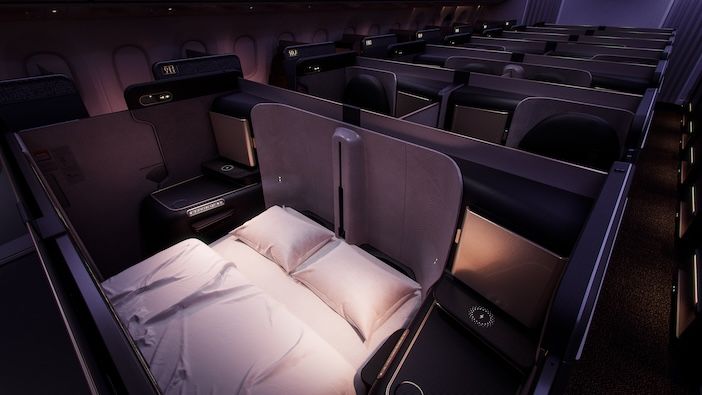
Korean Air’s 787-10 also features 289 economy-class seats in a 3-3-3 configuration. The seat pitch is 32 inches (81cm), and the seat width 17.2 inches (44cm). Comfort features include a recline function, adjustable headrests, and 13-inch (33cm) 4K IFE monitors (approximately 2 inches larger than on the rest of the airline’s fleet).
The cabins have been designed in collaboration with the PriestmanGoode studio, which was originally commissioned in 2018 to transform the airline’s interiors, addressing Korean Air’s need for a refreshed and modernised design vision that will lead it into its next phase as a global 5-Star airline. The goal was to create a sophisticated and modern atmosphere.
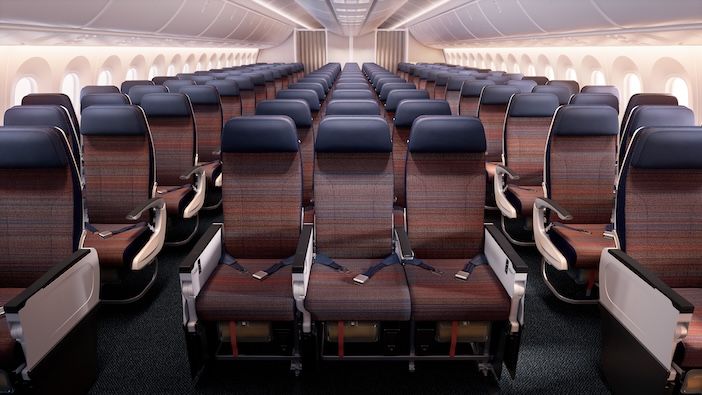
As part of the new visual identity, three key elements were developed and integrated around the themes of colour, pattern, and form. The overall approach combines traditional Korean culture with a modern interpretation, seamlessly blending these elements to craft what PriestmanGoode calls a “contemporary yet culturally resonant look”.
The three custom patterns developed by PriestmanGoode’s colour, material and finish (CMF) team each offer a contemporary take on traditional Korean textile art. The first pattern draws inspiration from Jogakbo patchwork craft, featuring geometric shapes and structured designs in a modern repeating motif. This pattern has been applied across the cabin interior within curtain and foil designs.
The second pattern draws from the linear dynamic structures from the Jogakbo pattern, and reinterpreted into a contemporary embroidered stitch design within the soft interior panels of the seats.
The third pattern incorporates vibrant colours from Hanbok saekdong (traditional Korean clothing), creating a lively design that reflects Korea’s cultural diversity and global connections. This pattern has been applied to the economy seats.
In addition to the cultural references, inspiration from luxury automotive and domestic textures combined make the interior feel luxurious. For example, the cream-coloured textiles are inspired by Joseon Dynasty porcelain, and the gold hues are reminiscent of brassware. Several branding elements were delivered by Bucher.
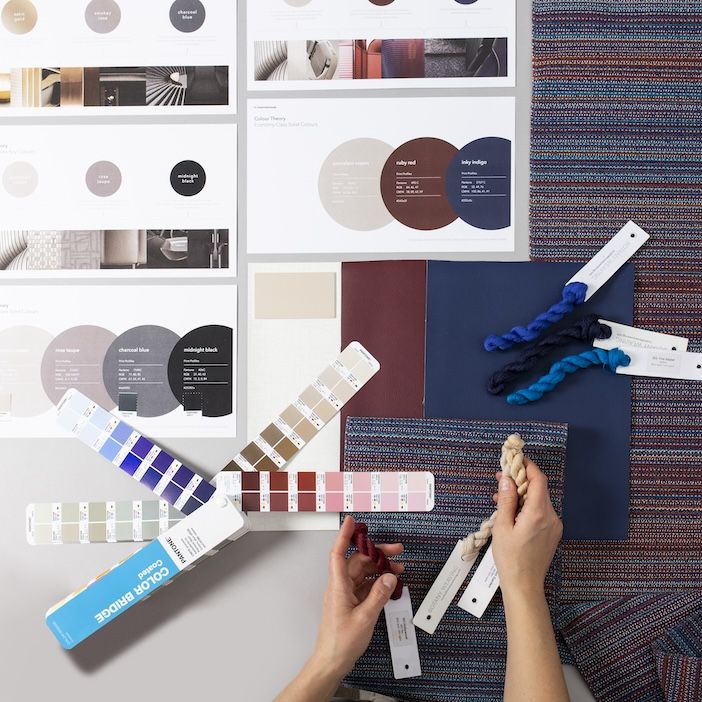
Commenting on the new identity and cabin designs, Daniel MacInnes, director of PriestmanGoode said: “Korean Air invests confidently in design to achieve unique levels of cabin detailing and quality for their passengers. We’ve achieved a new contemporary vision of Korean identity which is a timeless product but firmly recognisable for Korean nationals and interesting for the airline’s global customer base.”
At this week’s Farnborough International Airshow, Walter Cho, chairman and CEO of Korean Air, announced its intent to purchase 20 Boeing 787-10s (with options for 10 more), plus 20 Boeing 777-9s. The 777-9s and 787-10s, with their capability of long-haul flights to regions such as North America and Europe, are expected to play an important role after Korean Air’s expected merger with Asiana Airlines.
Korean Air will launch its inaugural flight of the B787-10 on 25th July from Seoul Incheon to Tokyo Narita. The aircraft will initially be deployed on short-haul routes to ‘stabilise’ operations, before being deployed on long-haul routes such as the Seoul Incheon-Vancouver route.
Korean Air plans to use the B787-10s on key high-demand trunk routes to leverage its range, new hardware products, and fuel efficiency, including flights to the western USA and Europe. The airline notes it has seen significant travel demand for its Vancouver routes, as well as significant transit traffic from Southeast Asia.
